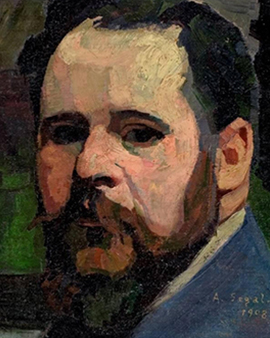


Arthur Aron Segal, born July 13, 1875 in Jassy, Romania and died June 23, 1944 in London, was an artistic phenomenon of the early 20th century. This Romanian painter left behind an impressive artistic landscape that is still viewed and admired today in the form of art prints. The scion of a Jewish banker, his story began in Botoșani before moving to Berlin in 1892 to study at Eugen Felix Prosper Bracht. Here he became part of Berlin's vibrant artistic circle and married his cousin Ernestine in 1904. Together they became involved in the local art scene and formed the Neue Secession - a reaction to the Berlin Secession. Their works were presented in various exhibitions before they withdrew in 1912 due to internal disagreements. During this time, Segal also traveled to Paris to expand his artistic vision.
The shadows of war brought great changes to Segal's life. An avowed pacifist, he left Berlin in 1914 and found refuge in Ascona, among the dropouts of Monte Verità. Here he founded a painting school and created an inspiring meeting place for exiled artists. This place of creativity attracted many renowned artists, including Hans Arp, Marianne von Werefkin, Alexej von Jawlensky and Lou Albert-Lasard. Between 1914 and 1920, Segal coined the principle of equivalence, a technique in which he assigned equal importance to his subjects and figures in a grid of rectangles placed on the painting. This move away from representationalism to an art dominated by prismatically decomposed colors still characterizes his style today, which is reflected in every art print.
When Segal returned to Berlin in 1920, he joined the November Group and opened his own painting school in Berlin-Charlottenburg. This soon became a popular meeting place for avant-garde artists. When Nazi rule began in 1933, Segal fled Germany and went to London via Mallorca. Here he founded the "Arthur Segal Painting School" in 1936, which lasted until 1977. Although the Nazis confiscated nine of his works in the "Degenerate Art" campaign and destroyed some of them, Segal's art has survived the test of time and continues to inspire people worldwide. Each art print we offer is a tribute to his tireless spirit and unique vision. Segal's final days were marked by an air raid on London, after which he died of heart failure. He left behind a significant heir in the form of his son, architect Walter Segal, and a legacy of artwork that endures in fine art prints.

Arthur Aron Segal, born July 13, 1875 in Jassy, Romania and died June 23, 1944 in London, was an artistic phenomenon of the early 20th century. This Romanian painter left behind an impressive artistic landscape that is still viewed and admired today in the form of art prints. The scion of a Jewish banker, his story began in Botoșani before moving to Berlin in 1892 to study at Eugen Felix Prosper Bracht. Here he became part of Berlin's vibrant artistic circle and married his cousin Ernestine in 1904. Together they became involved in the local art scene and formed the Neue Secession - a reaction to the Berlin Secession. Their works were presented in various exhibitions before they withdrew in 1912 due to internal disagreements. During this time, Segal also traveled to Paris to expand his artistic vision.
The shadows of war brought great changes to Segal's life. An avowed pacifist, he left Berlin in 1914 and found refuge in Ascona, among the dropouts of Monte Verità. Here he founded a painting school and created an inspiring meeting place for exiled artists. This place of creativity attracted many renowned artists, including Hans Arp, Marianne von Werefkin, Alexej von Jawlensky and Lou Albert-Lasard. Between 1914 and 1920, Segal coined the principle of equivalence, a technique in which he assigned equal importance to his subjects and figures in a grid of rectangles placed on the painting. This move away from representationalism to an art dominated by prismatically decomposed colors still characterizes his style today, which is reflected in every art print.
When Segal returned to Berlin in 1920, he joined the November Group and opened his own painting school in Berlin-Charlottenburg. This soon became a popular meeting place for avant-garde artists. When Nazi rule began in 1933, Segal fled Germany and went to London via Mallorca. Here he founded the "Arthur Segal Painting School" in 1936, which lasted until 1977. Although the Nazis confiscated nine of his works in the "Degenerate Art" campaign and destroyed some of them, Segal's art has survived the test of time and continues to inspire people worldwide. Each art print we offer is a tribute to his tireless spirit and unique vision. Segal's final days were marked by an air raid on London, after which he died of heart failure. He left behind a significant heir in the form of his son, architect Walter Segal, and a legacy of artwork that endures in fine art prints.
Page 1 / 1






